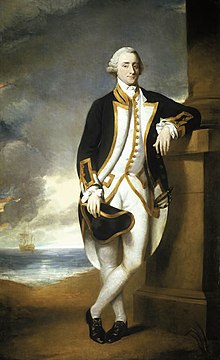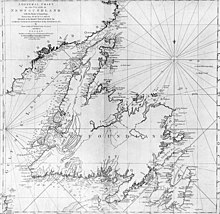Hugh Palliser
Sir Hugh Palliser, 1st Baronet (born February 22, 1722 in Kirk Deighton (West Yorkshire), England, † March 19, 1796 in Chalfont St Giles, England) was a British naval officer in the Royal Navy during the Seven Years' War and the American War of Independence .

Career
Hugh Palliser was born in Kirk Deighton, West Yorkshire, in 1722 to Hugh Palliser and Mary Robinson. He started a career in the Royal Navy. In 1735 he became a midshipman on the HMS Aldborough , which was commanded by his uncle Nicolas Robinson. He followed his uncle to other ships, including a. the HMS Kennington , the HMS Tiger and the HMS Essex .
In 1741 he reached the rank of lieutenant under Captain John Norris on the Essex . In July 1746 he became first officer on the HMS Weazel and in November 1746 captain on the HMS Captain . As the captain of HMS Sutherland , he returned to England to recover from some injuries. After a successful recovery, he was reappointed captain, this time on HMS Sheerness . He held this post until the ship was decommissioned in 1750.
During the Seven Years' War he commanded the HMS Eagle and from 1758 the HMS Shrewsbury . He then served in the Canal Fleet under George Anson and in 1759 was involved in operations during the Battle of the Plains of Abraham in Quebec , Newfoundland . In the same year he received the order to recapture the settlement of St. John's from the French, but they had surrendered the day before his arrival and he was able to take the oldest English settlement in North America without a fight.
Governor of Newfoundland
After the final formal abandonment of their colonies in Canada in the Peace of Paris in 1763 by the French, Palliser was appointed governor of the colony of Newfoundland in 1764 . In this position, which he held for four years, he was also Commander-in-Chief of the colony's fleet, the Newfoundland Squadron . In this role he actively supported the establishment of a fishery in order to have seafarers trained for the Royal Navy.
In 1770, meanwhile he had returned to Great Britain, the financial administration of the Navy was transferred to him. On August 6, 1773 he was given the hereditary title of Baronet , of The Vache in the County of Buckingham , in the Baronetage of Great Britain . In 1774 he was elected to the British House of Commons for his constituency of Scarborough , North Yorkshire . In 1775 he was appointed Rear Admiral , and under John Montagu, 4th Earl of Sandwich , he became one of the Lords of the Admiralty and received the payment of a lieutenant general in the marine infantry . In 1778 he was named Vice Admiral of the Blue Flag (seventh highest rank in the British Navy). Apparently he had good connections within the Admiralty and was given preferential treatment by superiors like Sandwich. When the political climate changed, however, the avowed Tory was placed under the command of Admiral Augustus Keppel , a Whig , opponent of the war against the American colonies and commander in chief of the Canal Fleet.
American War of Independence
The political clashes between the two adversaries should also be reflected on the battlefield. In the first battle of Ouesant , which was unsuccessful, Palliser refused to pursue the French squadron, which was retreating in poor seas. The subsequent maritime court proceedings, which were passionately commented on by the press organs of both parties, ended with the dismissal of Keppels and Palliser, and disputes within the Royal Navy intensified.
In 1780, however, on the initiative of Sandwich, he was appointed chairman of the largest British maritime hospital , Greenwich Hospital , and that same year was elected to Parliament as a candidate for the constituency of Huntingdon for four years. In 1787 he was finally appointed admiral.
Hugh Palliser died in 1796 on his country estate "Vache" in Chalfont St Giles .
Hugh Palliser and James Cook
James Cook served as the chief boatswain on HMS Eagle under Palliser between 1755 and 1758. Palliser evidently recognized Cook's abilities and supported his appointment as lieutenant in 1757. Cook, an excellent cartographer, helped Palliser prepare for the conquest of Québec during the Battle of the Abraham Level. After being appointed governor of Newfoundland, Palliser commissioned Cook to draw up a map of the province which, once published, was widely admired for its level of detail.
With Cook's first expedition voyage in 1768, which was supported politically and financially by Palliser, the two men parted ways. Cook has not forgotten his sponsor and named the Palliser Islands in French Polynesia , a bay at the southern end of the North Island of New Zealand ( Palliser Bay ) and the southernmost point of the North Island of New Zealand ( Cape Palliser ) after him.
After the assassination of Cook on the beach in Hawaii in 1779, Palliser erected a memorial to him on his estate.
swell
- Charnock, Biographia navalis , V, 483-96.
- Hunt RE, The life of Sir Hugh Palliser , (London, 1844).
Web links
- Cook monument in Chalfont St. Giles (English)
- Biographical data (English)
- Detailed biography (English)
| predecessor | Office | successor |
|---|---|---|
| Thomas Graves |
Commodore Governor of the Colony of Newfoundland 1764–1768 |
John Byron |
| personal data | |
|---|---|
| SURNAME | Palliser, Hugh |
| ALTERNATIVE NAMES | Palliser, Sir Hugh, 1st Baronet |
| BRIEF DESCRIPTION | British Admiral in the Royal Navy |
| DATE OF BIRTH | February 22, 1722 |
| PLACE OF BIRTH | Kirk Deighton (West Yorkshire) |
| DATE OF DEATH | March 19, 1796 |
| Place of death | Chalfont St Giles, England |
